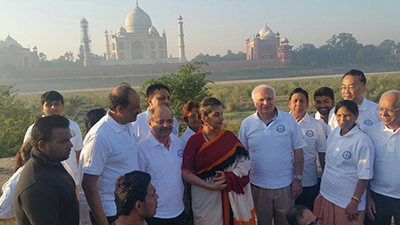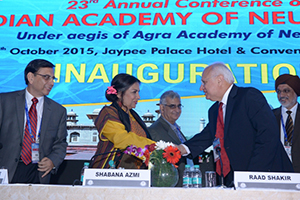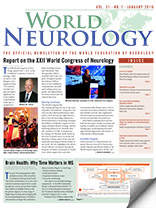By Gagandeep Singh, Arabinda Mukherjee and Pardeep Kumar Maheshwari

The Taj Mahal plays as backdrop as delegates gather during the Clean India campaign held during the conference.
The 23rd Annual Conference of the Indian Academy of Neurology (IAN) was held Oct. 1–4, 2015, at Agra, the city of Taj, in India. Planning the IAN scientific program with sizeable professional body of clinical neurologists in India is always a challenging task for two reasons. For one, India is a country with 1.28 billion people with about 1,800 neurologists, which amounts to one neurologist for 7,00,000.
This entails providing each neurologist with updated knowledge so as to be able to deal with a wide range of neurological disorders, including tropical infections and toxin-induced disorders, besides the usual neurological conditions managed by Western neurologists. The demand on neurologists requires the ability to deal with a large patient pool with diverse neurological conditions. At the same time, recent technological and conceptual advances require that neurologist have the ability to provide state-of-the-art tertiary care to patients who require such care.

WFN President Raad Shakir greets Shabana Azmi during the inaugural ceremony.
A unique solution to this paradox is to have neurologists who practice high-technology neurology provide continuing education to neurologists involved largely in community care. This allows the Academy to be self-sufficient and caters to the educational needs of all. The scientific program of IANCON 2015 reflected the principle to ensure that public perception within the nation, as well as internationally, befitted. The distinguished guests included Shabana Azmi, a noted film actor and social activist, and WFN President Prof. Raad Shakir, president, World Federation of Neurology.
The Conference featured 14 breakfast and lunch symposia, a CME, four breakfast symposia, two guest lectures, four orations and 267 papers.
To cater to the tastes of trainee neurologists, a barbecue quiz — with an initial countrywide online round and a final round during the conference — and a clinic-pathological conference were other hallmarks of the conference.
Even as India needs many more neurologists, the number is increasing with 171 trained neurologists added each year. The scenario is certainly encouraging, as the IAN is becoming a stronger constituent of the World Federation of Neurology, the support of which we gladly acknowledge.
